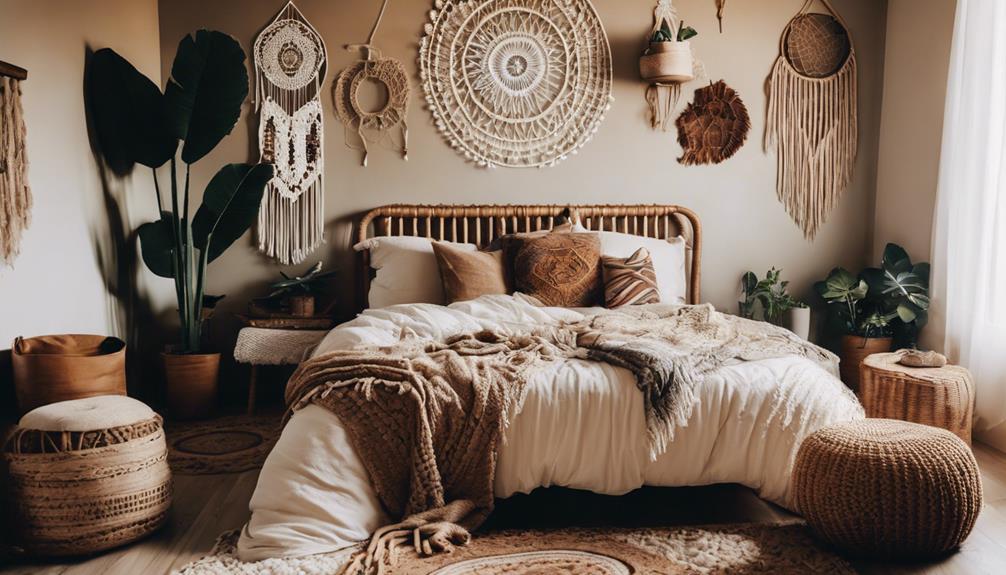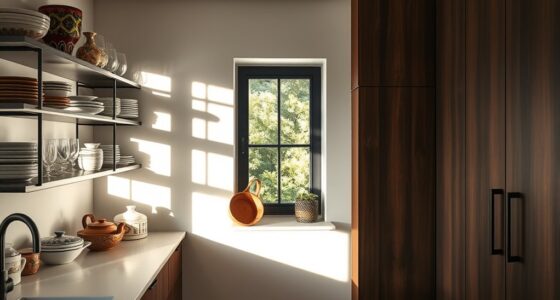Wall molding and trim styles have evolved from ornate, classical designs to sleek, modern lines that suit any interior. Classic styles feature intricate details and symmetry, adding elegance, while contemporary options focus on clean, minimalist profiles with subtle textures. Materials range from traditional wood to eco-friendly options like recycled MDF. Choosing the right style depends on your theme, and proper installation helps create a cohesive look. Keep exploring to discover how you can incorporate these trends into your space.
Key Takeaways
- Wall molding styles range from ornate, classical designs to sleek, minimalist modern trims.
- Classic moldings feature intricate details and symmetry, while modern styles emphasize clean lines and simplicity.
- Material options include reclaimed wood, MDF, PVC, and solid wood, matching different aesthetics and budgets.
- Selecting the right molding style enhances interior themes, from traditional elegance to contemporary minimalism.
- Combining different molding styles creates unique, layered wall designs that reflect personal taste and architectural interest.
The History and Evolution of Wall Molding and Trim

Wall molding and trim have a long history that reflects changing architectural styles and craftsmanship. Over time, these elements evolved from simple decorative borders to integral parts of interior design, enhancing furniture integration and overall aesthetics. During the classical period, moldings were ornate, emphasizing grandeur and elegance, often coordinated with furniture styles and color schemes to create a cohesive look. As design moved toward minimalism, wall trim became sleeker, focusing on clean lines and subtle details that complemented modern furniture and color palettes. The evolution of wall molding demonstrates how craftsmanship adapted to cultural trends, balancing form and function. Additionally, the integration of smart home devices now allows for remote control of lighting and climate, seamlessly blending traditional design elements with modern technology. Today, understanding this history helps you appreciate how moldings can unify your space, blending architectural detail with your personal style and interior color coordination.
Classic Wall Molding Styles and Their Characteristics
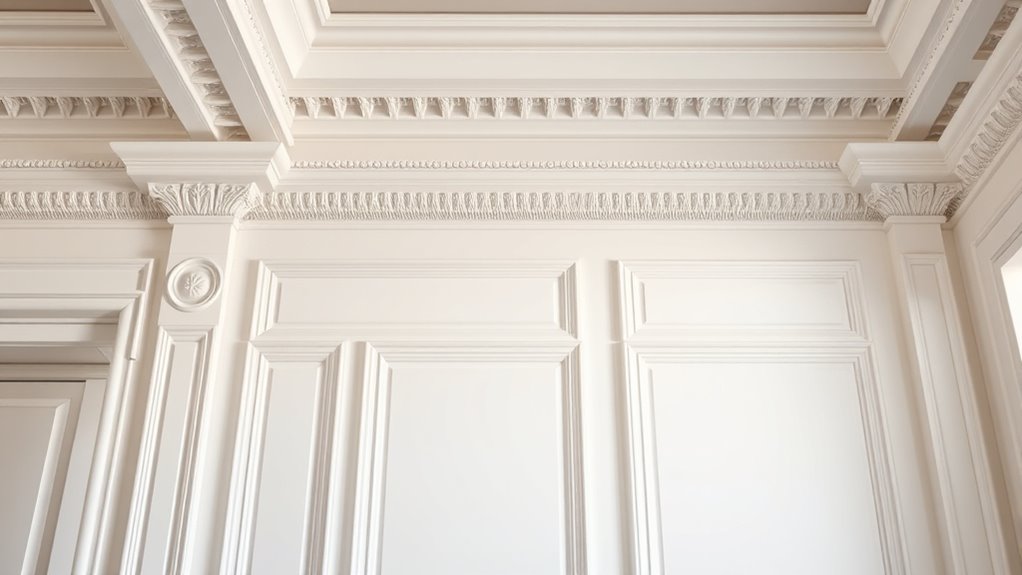
Classic wall molding styles often feature ornate details that add elegance to a room. You’ll notice that symmetry plays a key role, creating a balanced and harmonious look. These styles emphasize intricate craftsmanship and timeless design elements. Additionally, costume themes such as superhero and princess designs often incorporate classic motifs to evoke a sense of nostalgia and tradition.
Ornate Moldings and Details
Ornate moldings and intricate details have long been prized for adding elegance and character to interior spaces. These elaborate designs often serve as wall art, drawing attention and elevating the room’s aesthetic. They pair beautifully with rich color schemes, such as deep jewel tones or soft pastels, to enhance their luxurious appeal. You might choose highly detailed crown moldings or decorative friezes that feature floral motifs, scrolls, or geometric patterns. These elements create a sense of grandeur and craftsmanship, making your walls a focal point. When incorporating ornate moldings, consider how they complement other design features and your overall style. Their intricate details give your space a timeless charm, blending classic sophistication with personalized flair.
Symmetry in Design
Symmetry plays an essential role in creating balanced and harmonious wall molding designs that evoke a sense of order and elegance. When designing with symmetry, you’ll want to consider how color palettes enhance this effect; matching or complementing colors on either side reinforces balance. Lighting effects also play a pivotal role—placing lights to highlight symmetrical features accentuates their harmony and draws attention to the moldings’ details. In classic wall molding styles, symmetry often involves mirror-image panels and evenly spaced trim elements, creating a formal and refined look. By carefully aligning moldings and choosing cohesive color schemes, you can achieve a timeless aesthetic that feels both intentional and captivating. Incorporating Pimple Patches into your skincare routine can also contribute to a clearer complexion, which complements the polished look of your walls. Symmetry not only enhances visual appeal but also establishes a sense of stability within your space.
Modern and Minimalist Trim Designs

Modern and minimalist trim designs emphasize clean line details that create a sleek, uncluttered look. You’ll notice subtle textural accents that add depth without overwhelming the space. These styles focus on simplicity, making your room feel open and refined. Incorporating current design trends can further enhance the contemporary aesthetic of your interior.
Clean Line Details
Clean line details are the hallmark of modern and minimalist trim designs, emphasizing simplicity and sleekness. You’ll notice how these designs favor straight, unembellished edges that create a streamlined look. To enhance this aesthetic, consider color palettes that are neutral or subdued, which complement the clean lines without distraction. Lighting effects also play a vital role—sharp, focused lighting can highlight the crispness of the trim, casting subtle shadows that add depth without clutter. By avoiding ornate details, you allow the space to feel open and uncluttered. This approach creates a calm, contemporary atmosphere where every element serves a purpose, and the simple design principles act as a foundation for a sophisticated, minimalist interior.
Subtle Textural Accents
While clean lines define the sleekness of minimalist trim, adding subtle textural accents introduces a layer of depth without cluttering the design. You can achieve this through slight variations in surface finishes or delicate patterns that create a gentle textural contrast. These accents draw the eye without overwhelming the space, maintaining a modern aesthetic. Incorporate subtle color accents, like soft hues or muted metallics, to enhance the visual interest further. By combining texture and color thoughtfully, you add nuance while preserving simplicity. This approach keeps your walls feeling fresh and sophisticated, emphasizing quality over ornamentation. Ultimately, subtle textural accents allow you to personalize minimalist spaces, making them more inviting without sacrificing their clean, streamlined look.
Ornate and Decorative Molding Options
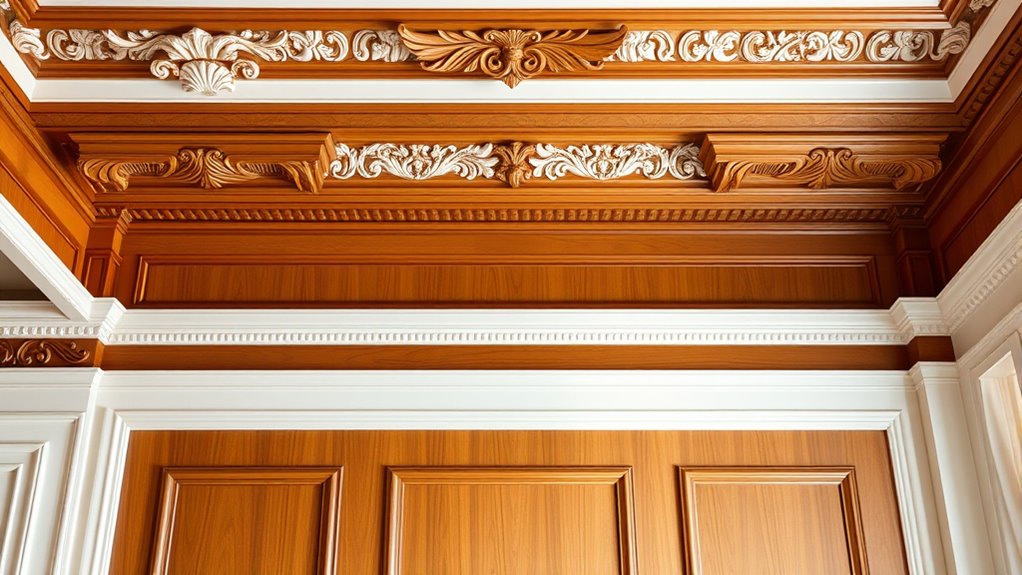
Ornate and decorative molding options can instantly elevate the character of your space, adding a touch of elegance and sophistication. These intricate designs often draw inspiration from famous architects and cultural influences, reflecting a rich history and craftsmanship. You might choose elaborate crown moldings or ornate ceiling medallions that evoke classical grandeur, or opt for detailed filigree patterns inspired by European or Asian traditions. Such moldings create a focal point, transforming simple walls into works of art. They’re perfect for adding depth and personality to formal living rooms, dining areas, or historical homes. By selecting these decorative elements, you connect your space to a broader design heritage, making your interior uniquely refined and culturally expressive. Design heritage plays a key role in shaping these ornate choices, enriching the aesthetic appeal of your space.
Materials Used in Wall Molding and Trim
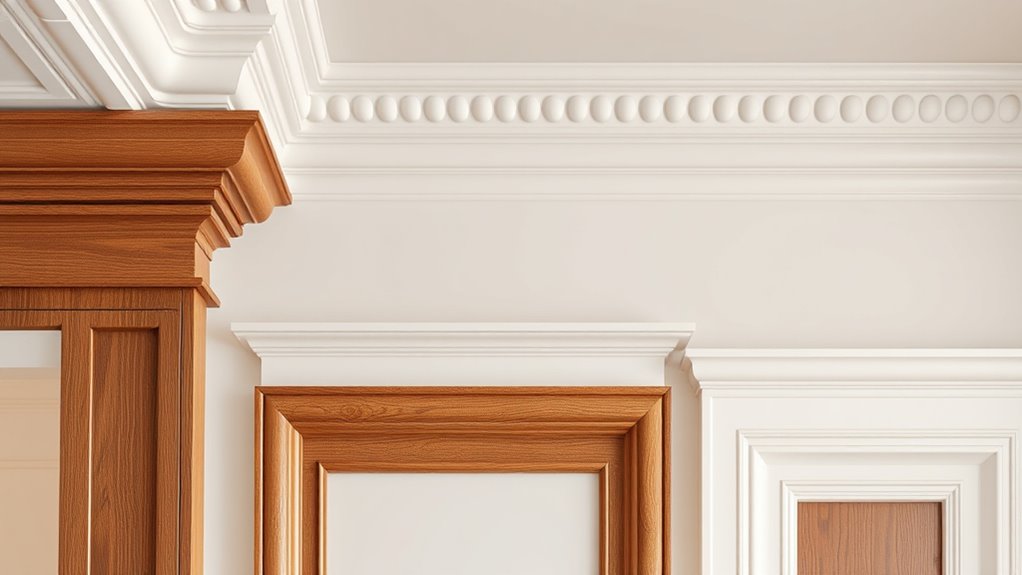
What materials do you choose for wall molding and trim can markedly impact both the appearance and durability of your project. If you’re aiming for eco-friendly options, sustainable materials like reclaimed wood, bamboo, or MDF made from recycled fibers are excellent choices. These materials not only reduce environmental impact but also offer durability and ease of customization. For a budget-friendly approach, consider options like medium-density fiberboard (MDF) or PVC, which are cost-effective and resistant to moisture. Solid wood provides a classic, high-end look but tends to be pricier and requires more maintenance. Ultimately, your choice depends on your style preferences, budget, and sustainability goals, ensuring your wall molding and trim enhance your space while aligning with your values. Incorporating textile art techniques such as textured finishes or decorative accents can also add a unique, personalized touch to your molding design.
Choosing the Right Style for Different Interior Themes

Choosing the right style of wall molding and trim can considerably enhance the overall look of your interior, so it’s important to select designs that complement your space’s theme. For a traditional or classic interior, opt for detailed, ornate moldings that add elegance. Modern themes benefit from sleek, minimalist trims with clean lines, emphasizing simplicity. Consider color coordination by matching or contrasting trim colors with your wall paint to create visual harmony or focal points. Lighting integration also plays a role; in rooms with layered lighting, choose styles that don’t overshadow fixtures but enhance them. By aligning your molding style with your interior theme, color choices, and lighting, you’ll create a cohesive, polished look that elevates your space’s aesthetic. Incorporating appropriate trim styles can also serve to highlight architectural features and define different areas within a room.
Installation Tips for Various Molding Styles

Installing different styles of wall molding requires attention to detail and proper techniques to guarantee a polished finish. Start by measuring and marking your wall to ensure precise placement, especially for intricate or modern designs. Use a level to keep moldings straight and a miter saw for clean, accurate cuts at corners. When choosing paint color palettes, consider how the molding will interact with wall and trim colors to create harmony. Properly securing moldings with nails or adhesive is essential for stability, and filling nail holes with putty results in a seamless look. Also, think about furniture placement strategies; placing furniture away from moldings highlights their details and prevents damage. Incorporating unique and wicked planters can further enhance the aesthetic appeal of your space, complementing your moldings. With careful installation, your moldings will elevate your space’s style and cohesion.
Combining Different Molding Styles for a Unique Look

Mixing different molding styles can add visual interest and depth to your space, creating a custom and eclectic look. Layered combinations of molding styles allow you to highlight architectural details and personalize your room. For example, pairing traditional crown molding with sleek, modern baseboards creates a striking contrast. Incorporating mixed materials, like wood and metal accents, enhances the layered effect and adds texture. When combining styles, keep a balance so the overall look feels intentional rather than chaotic. Use different heights, profiles, or finishes to differentiate each molding type while maintaining harmony. This approach lets you experiment with various aesthetics—classic, contemporary, or bohemian—while creating a unique, personalized environment that reflects your style. Additionally, choosing luxury wallpapers with bold patterns or textures can further emphasize the layered design and elevate the overall aesthetic.
Trends in Wall Molding and Trim for Contemporary Spaces
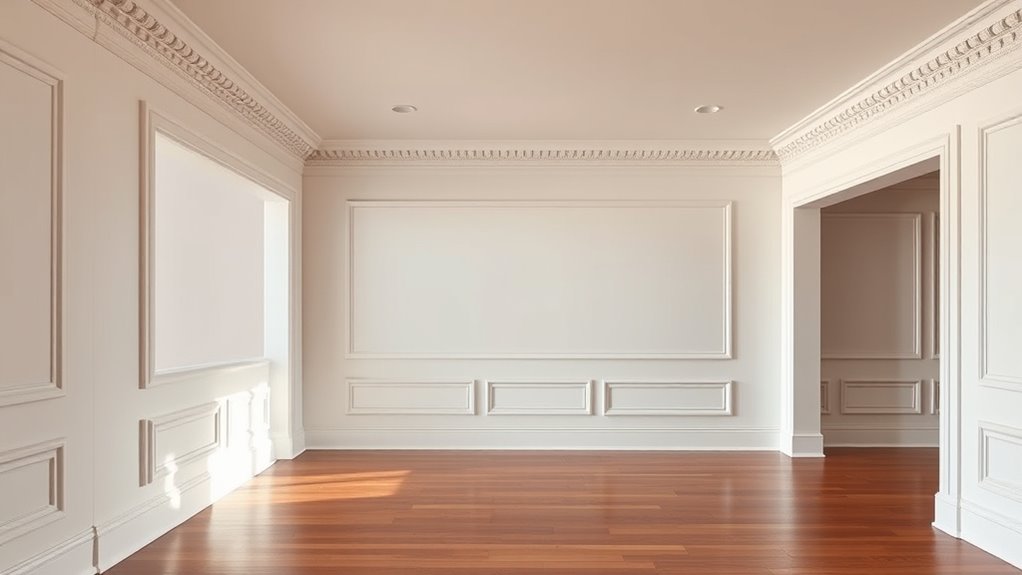
Modern interiors are embracing wall molding and trim styles that emphasize clean lines and minimalist aesthetics. You’ll notice a shift toward subtle, streamlined profiles that complement soft, neutral color palettes. These choices create a calm, cohesive environment, allowing space for bold lighting techniques to stand out. Incorporating layered or indirect lighting highlights the trims’ crisp edges and adds depth to your walls. Matte finishes and monochromatic tones are popular, enhancing the sleek look of contemporary spaces. You can also experiment with contrasting colors or textures on trims and walls to add visual interest without clutter. This trend focuses on simplicity and functionality, making your space feel open, fresh, and modern while showcasing your attention to detail in design elements like molding and trim. Additionally, exploring different styles of anime movies can inspire creative design elements in your space, blending cultural influences with modern decor.
Frequently Asked Questions
How Can Wall Molding Improve a Room’s Acoustics?
Wall molding can improve your room’s acoustics by providing acoustic enhancement, reducing echoes and noise. It helps break up flat surfaces, preventing sound from bouncing around excessively. Additionally, wall moldings can add a layer of sound insulation, dampening external noise and keeping your space quieter. By choosing the right style and material, you can create a more comfortable, acoustically balanced environment that suits your needs.
What Maintenance Is Required for Different Trim Materials?
You should regularly inspect your trim materials for damage or wear. For painted moldings, do paint touch-ups as needed to keep them looking fresh. Clean wooden or plaster trims with gentle cleaning routines, using a damp cloth to remove dust and grime without damaging the finish. For metal or vinyl trims, check for corrosion or cracks and address issues promptly. Proper maintenance guarantees your trim stays beautiful and durable over time.
Are There Eco-Friendly Options for Wall Molding Materials?
Imagine a room where eco-friendly wall molding whispers sustainability with every detail. You can choose sustainable materials like bamboo, reclaimed wood, or recycled trims to reduce environmental impact. These options blend beauty with responsibility, giving your space character and conscience. Recycled trims, in particular, let you enjoy stylish accents while supporting eco-conscious practices. By selecting these materials, you’re making a positive choice for both your home and the planet.
How Does Wall Molding Influence a Room’s Resale Value?
Wall molding can boost your home’s resale value by adding decorative patterns that appeal to buyers. It also highlights historical significance, making your space look more refined and unique. When you choose quality, stylish moldings, you show attention to detail, which can differentiate your property. This upgrade not only enhances aesthetics but signals good maintenance, making your home more attractive to potential buyers and increasing its market value.
What Are Cost-Effective Alternatives to Traditional Molding?
Think of your walls as blank canvases waiting for expression. You can achieve elegant detail with budget-friendly materials like foam or PVC, which are perfect for DIY installation. These alternatives symbolize creativity and resourcefulness, allowing you to transform your space without overspending. By choosing cost-effective options, you add character while staying within your budget, making your home more inviting and stylish without the hefty price tag of traditional molding.
Conclusion
Whether you prefer classic elegance, modern simplicity, or a blend of styles, wall molding and trim let you express your unique taste. By understanding their history, exploring different designs, and choosing the right materials, you can transform any space. Embrace your creativity, experiment with combinations, and stay current with trends. Ultimately, your choice of molding reflects your style, enhances your home’s character, and creates a timeless backdrop for your everyday moments.



